
A little more than three years ago, I wrote a post called I Quit: 2+ Years of Anki and the (Near) Impossibility of Learning Languages, discussing my travails in using flash cards to learn foreign languages. That post remains this website’s most popular by traffic, elicited extensive discussion in the comments, and also still triggers regular emails from readers asking questions about it.
But the reality is that I didn’t quit (although I did take a break), and I think I have finally managed to get Anki to work well for me. But that required understanding more about how I learn languages as well as customizing certain patterns of Anki for use with Korean, which has its own unique characteristics as a language.
Anki v.1 problems
To summarize the challenges I had with Anki the first time around:
- Too many words were lightly impressed in my head — at some point, there was just an overwhelming number of words that I couldn’t remember, despite running through flash cards on a daily basis.
- Synonyms made it very hard to keep track of words. Korean (like English, French, and I am sure other languages) has variations of the same meaning of a word, and that can make it challenging to do English to Korean and Korean to English vocabulary cards and keep them straight.
- The time it took to get through Anki’s daily cards just kept going up — what I dubbed at the time as the Anki treadmill. What started at 10-15 minutes per day soon morphed to 30 minutes to 50 minutes a day. That’s just not practical as a side hobby.
Fluent Forever’s approach (Anki v.2) and why it failed (at least for me)
After giving up Anki in frustration a couple of years ago, I started to reflect on how I learned languages and why foreign language learning remains so challenging.
One part of that thought process had to do with how linear we learn languages, when languages are actually more like graphs — with each word, phrase, and grammar point connected to each other. By erasing those connections, we do our brain a huge disservice, because we prevent it from placing a new piece of information within the context of everything else we have learned. I spent a bunch of time analyzing Korean and Chinese using Python on this front (unfortunately, I can be a lazy writer, so apologies for never posting any of those discoveries to the web).
I also sought out resources to just get better at language learning as a skill. I spent a bunch of time working and building upon Gabriel Wyner’s Fluent Forever, which is a good book as far as these go (he also now has an accompanying app which he crowdfunded, although I haven’t used it).
Wyner has many thoughts about learning languages, but his technique is essentially to use visual memory to more deeply imprint vocabulary into our brains, and to use audio files to focus on proper pronunciation. This focus on visual learning is the technique that comes out of Moonwalking with Einstein, the bestselling book by Joshua Foer about Foer’s training for the top U.S. memory competition.
Following along the lines of Fluent Forever, I basically built an Anki deck, finding pictures on Google Images that summarized a vocabulary word’s meaning and allowing my brain to graft on it. Per the book, I created cards that just showed the image and required me to respond with the underlying word prompt. I also downloaded Wyner’s pronunciation trainers and worked through those in Anki.
This new approach worked for a bit, and I probably got up to about 500 notes in this new model and was learning them regularly. However, there were some flaws with the Fluent Forever approach that makes it really hard to execute in reality.
First, the time it takes to create cards is a huge block for building up vocabulary. Finding the dictionary definition, then searching Google for photos, then resizing those photos to keep Anki’s storage down, then placing the photos into a card is extraordinarily time consuming. I am quite fast on a computer, but altogether this took 2-3 minutes per card if I was trying to do it right. Which means that in an hour of adding vocabulary, you might have added about 20-30 words. That’s just a glacial pace, at least for someone who doesn’t have too much extra time to be learning languages.
The second problem is more fundamental to the model. Just looking at a picture and then recalling its underlying word is not necessarily the only way someone wants to use language. Call this “the grocery store model” of vocabulary learning — you want to be able to point to a fruit or vegetable and say the word. But I like reading in foreign languages, and in reading, you don’t start with the image, you start with the word, and remembering an image from a word is … challenging, at least for me.
On the positive side, I felt that the pronunciation trainer actually helped a lot with identifying sounds. They are $12 each, which is very reasonable, and I bought Korean, Chinese, and French. The Korean one is sort of middling in quality (I’d rate 3.5 stars out of 5 if I am being very generous), but it works and has utility. I continue to study it in Anki, although at this point, cards only come up 2-3 times per week total.
Anki v.3 approach
So let me summarize some of the goals I had when I set out to “do Anki right” (at least, to do it right in how I wanted to use it).
- I wanted to be able to input cards quickly, since vocabulary growth is critical to language success and “fluency”
- Along the same lines, and taking feedback from comments on my last post, I wanted to make sure I could run through Anki flash cards really, really fast. 1-3 seconds max per card, with little to no thought required
- I still wanted to focus on things like business, politics, etc. that are interesting to me, and not reverting to textbook chapters on “how to check books out from the library” which I will never do in Korean in the rest of my life, or just memorize exam vocabulary
- I wanted to build card sets that worked in tandem with what I need in order to use the language. So cards that made sure I pronounced words properly, and cards that work on idiomatic expressions, etc.
My new Anki decks and card types
My main card type is a two-way Korean-English card, but which has a bit more information on it compared to perhaps other languages in order to support easier retention.
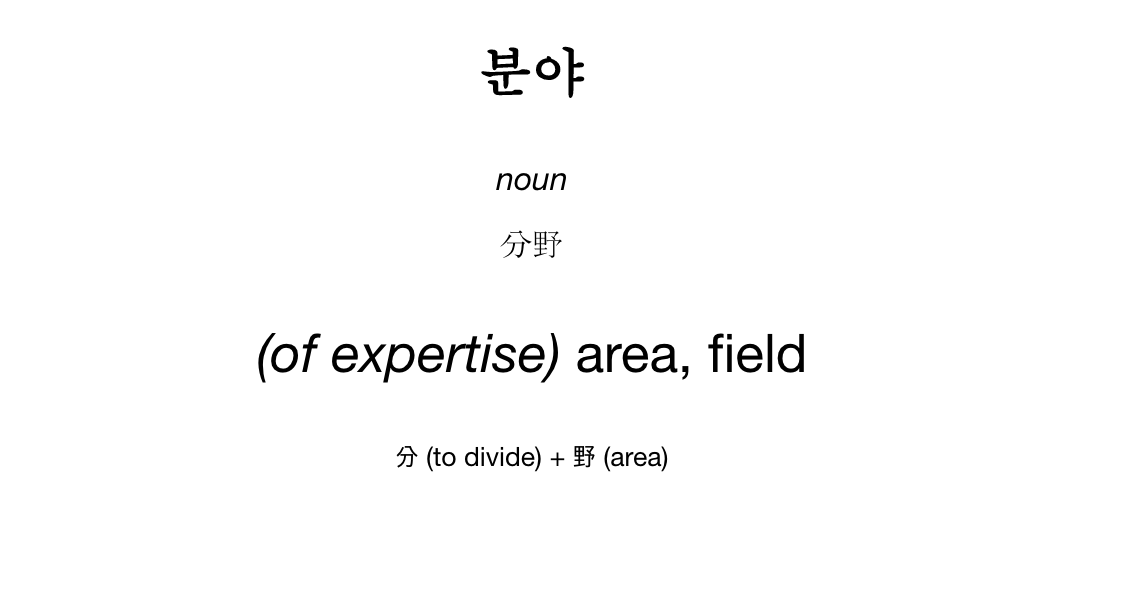
In addition to the obvious Korean and English words, I have a “History” field where I add in any Chinese character roots, which I look up on Naver Dictionary and then Wiktionary. Around 60% of Korean words derive from Mandarin Chinese, and while you certainly don’t need to learn Chinese characters to learn Korean, you can get used to the idea that a whole family of words with similar pronunciations are going to come from the same root and save yourself immense study time. I find that this context for a word massively helps me remember a large number of words.
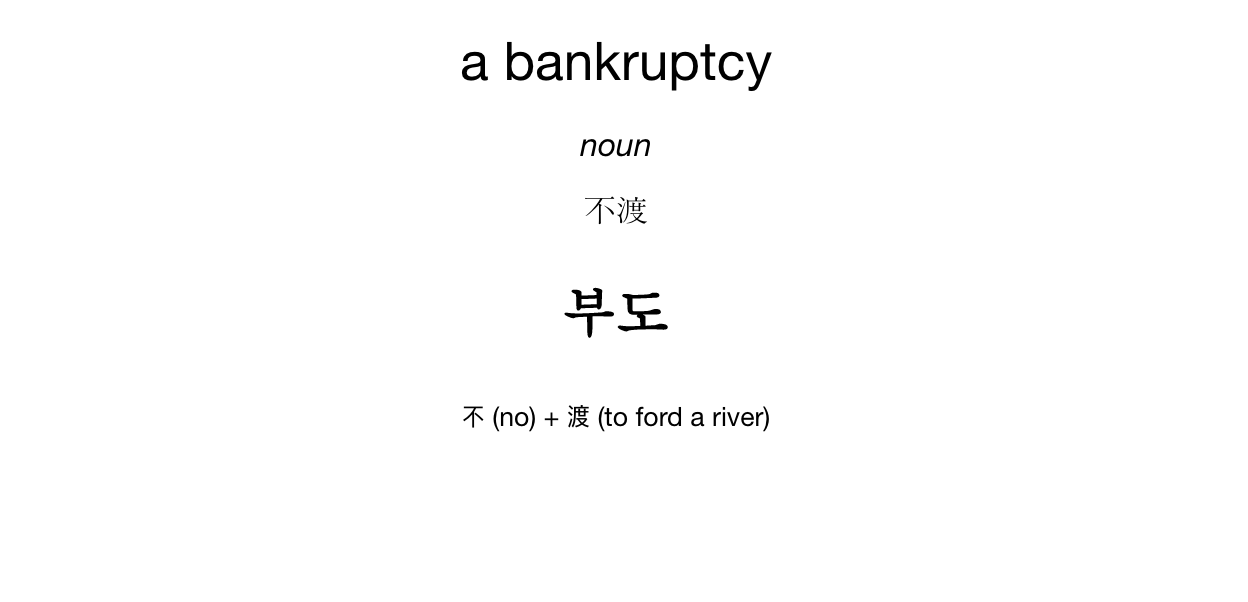
Let me give a random example to illustrate. The word for bankruptcy in Korean is 부도, which is based on the Chinese characters 不 (no, not, etc.) which is pronounced 부 or 불 in Korean and 渡 (to ford a river) which is pronounced 도 in Korean. So in Korean, bankruptcy literally means “not able to ford a river” which I take to mean “not able to pay the toll to cross the river.” Because of that history/story, I now have a great visual image of not just bankruptcy, but why bankruptcy is made up of the sounds 부 + 도.
Yes, that is more information than just the word itself, but that extra information offers the brain the connections it needs to firmly implant new information. Plus, once you know that 부 is 不, other words become clearer. To be impure is 불순 [不 (not) + 純 (pure)] while unequal is 부당 [不 (not) + 當 (to be equal to)]. We now have a connection through a number of words, but we only have to remember one sound.
There is a bit of caveat emptor here: Korean sounds are not unique to one Chinese character, so multiple characters can map to one sound. For instance, 순 can be ‘blink’ (瞬) or ‘pure’ (純) or ‘to obey’ (順). Nonetheless, getting the class of a sound whittled down to a few options can often make vocabulary much easier to place.
Beyond the history field, I also have a “Synonyms” field where I list synonyms. This sort of solved the synonyms problems from before, because I have to read through the synonyms and remember which one is missing from the set. Occasionally, I will select different English translations of words so that I can create a couple of independent sets (so for instance, absurd, ridiculously, crazy for a similar set of words in Korean). I try to avoid situations where there are more than 2-3 synonyms in one group, since otherwise, answering the card would take two long and violate one of my objectives with this new approach.
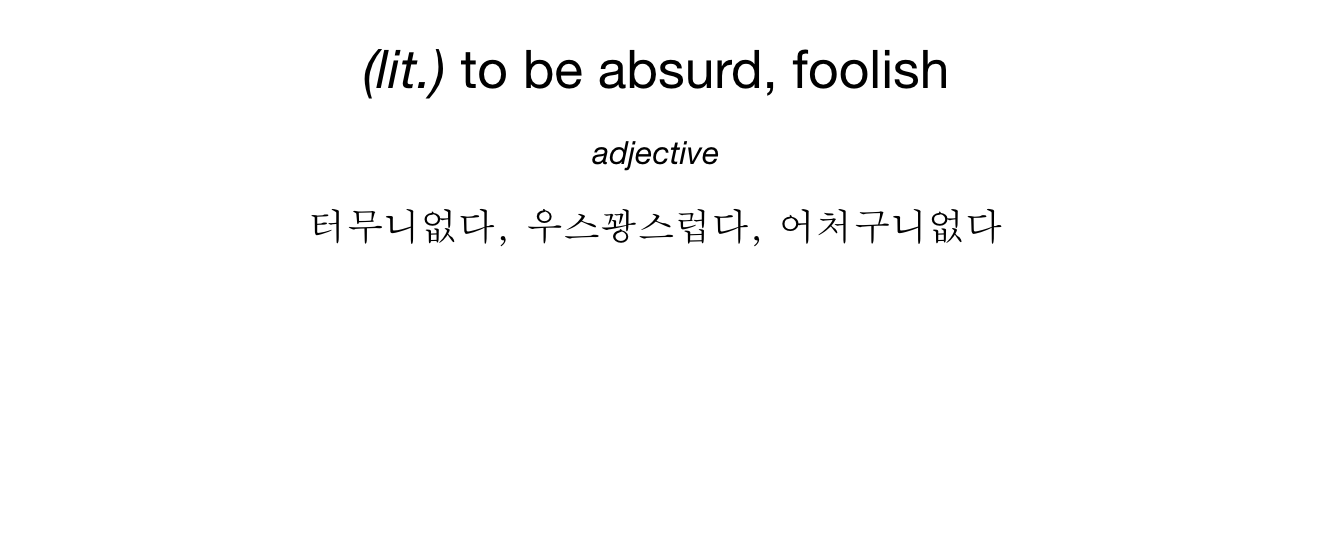
In addition to a few new fields, one thing that I did which helped a bit was upgrading the fonts in Anki. The defaults for Chinese and Korean are quite mediocre, but you can import others. I use AppleMyungjo, and you can add the font file into your Anki database and then reference it on a card using CSS. Anki’s documentation explains more.
@font-face { font-family: myfont; src: url(‘_myungjo.ttf’); }
That’s the main deck, which I have labeled just “Words.” I also have a “Pronunciation” deck where I display a Korean word in hangul, and then display its proper pronunciation also in Hangul. While Korean uses a sound system for writing, it has a bunch of pronunciation rules that can make it hard to perfectly sight-read. You can get the true pronunciation of words from Naver Dictionary’s native Korean page much as you would with a typical English dictionary. So for instance, 꽃잎 (flower petal) becomes 꼰닙 when pronounced.
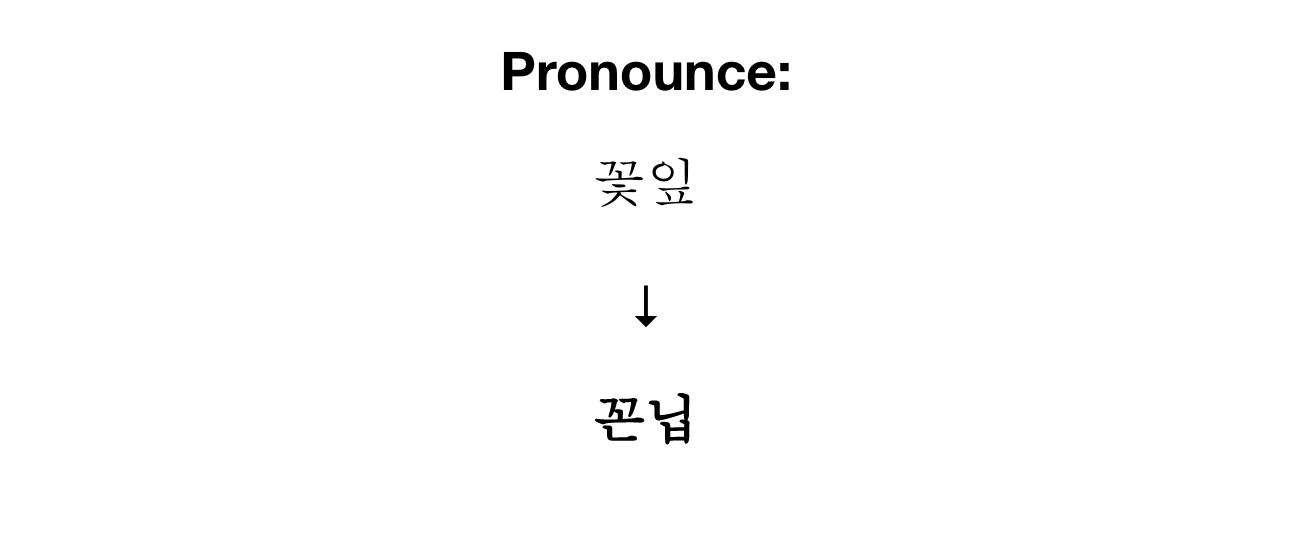
(As an aside, the best two books on Korean pronunciation I know of are The Sounds of Korean: A Pronunciation Guide by Miho Choo and William O’Grady and Korean Pronunciation Guide - How to Sound Like a Korean by Kim Ji Min and Yoon Shin Ae. I heartily recommend both).
Finally, I have a “Grammar” deck where I use (manual) cloze deletions to test grammar concepts. This is a bit more complicated and convoluted, but thankfully there isn’t an endless number of points to study here. Each note has up to 5 example sentences structured as cloze deletions, and then I have fields setup to explain the grammar concept once the answer is shown.
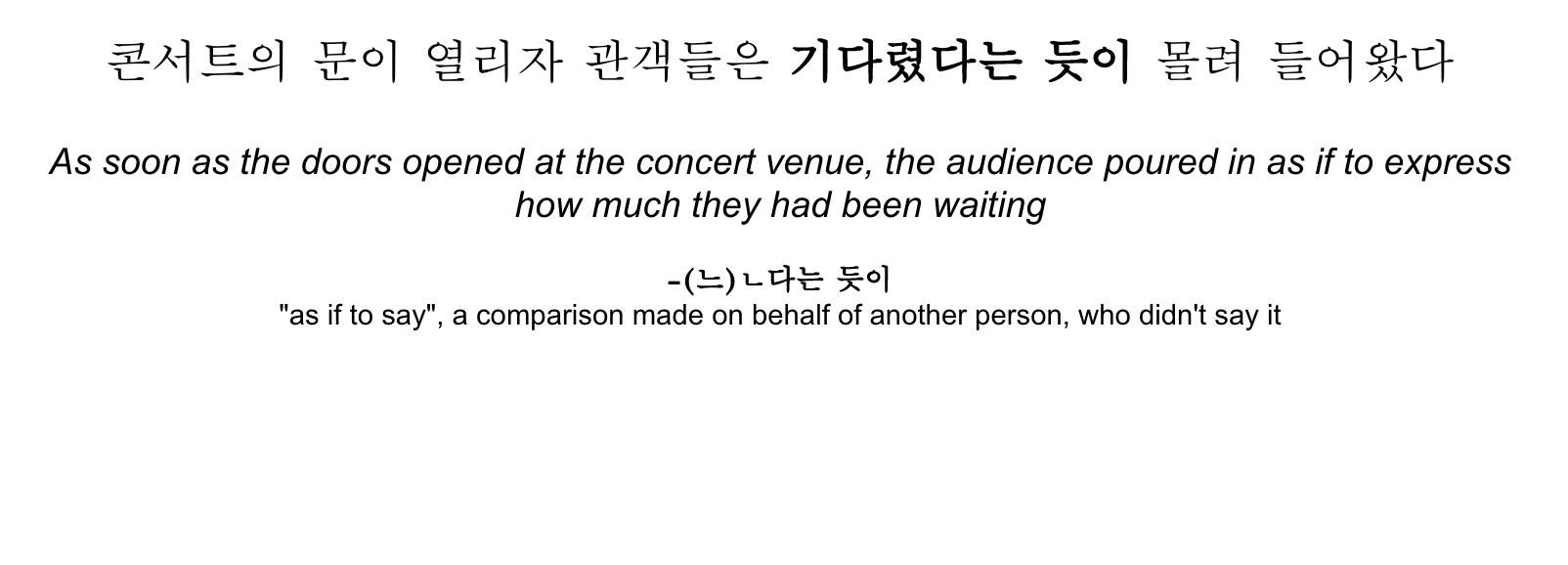
One reason I had to do this manually is that Anki doesn’t allow for multiple related cloze deletion cards. You can use the builtin note type for this. However, I didn’t want to study all five of my example sentences in one day. I tried finding a plugin for this, but never really found anything that perfectly did what I wanted to here.
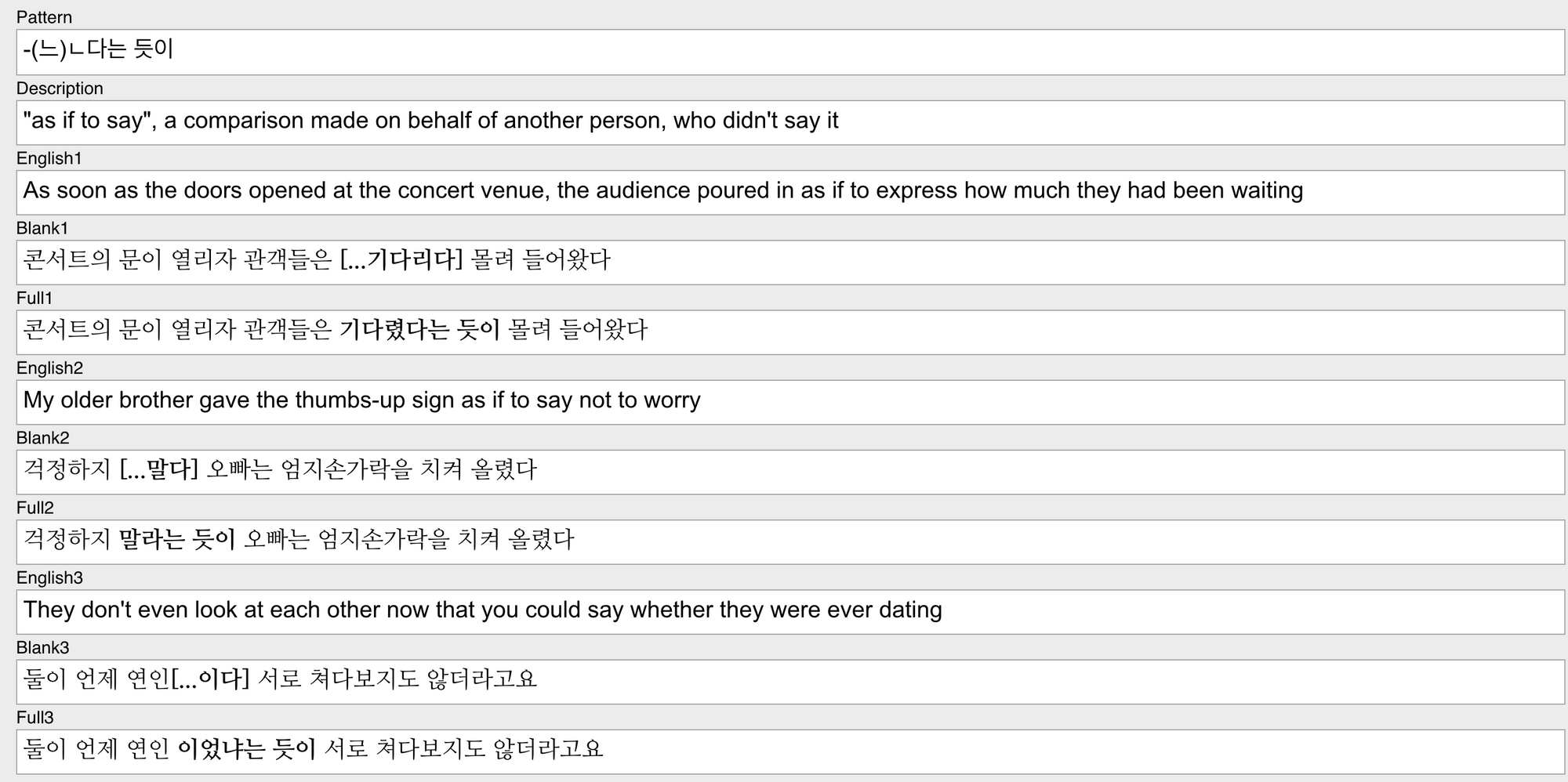
That’s basically it. So through these cards, you learn words, pronunciations, and grammar points.
My learning process
Using cards without some sort of process though is setting yourself up for failure, so I want to talk a bit about how Anki fits into a language learning system.
I think the first goal of all language learning should be context — you need to remember where a grammar point or vocabulary word comes from. A textbook series generally gives you this for free obviously, although I find the artificial nature of such books very hard to imprint in my mind.
My main approach has been to start out with a novel and its English translation equivalent. I am reading The Plotters by Unsu Kim (설계자들 by 김언수), which is sort of a Korean noir crime novel. I’ve read the entire book in English, and then I bought a Korean copy and am working through it page by page. Here is what is magical about this — sometimes the text gets hard with a dense thicket of impenetrable vocabulary, and when that happens, I just switch to the English version, read the paragraph, gain understanding, and then revert back to the Korean version. Thankfully, this novel’s translation is very close to the original, and so it is almost one-to-one.
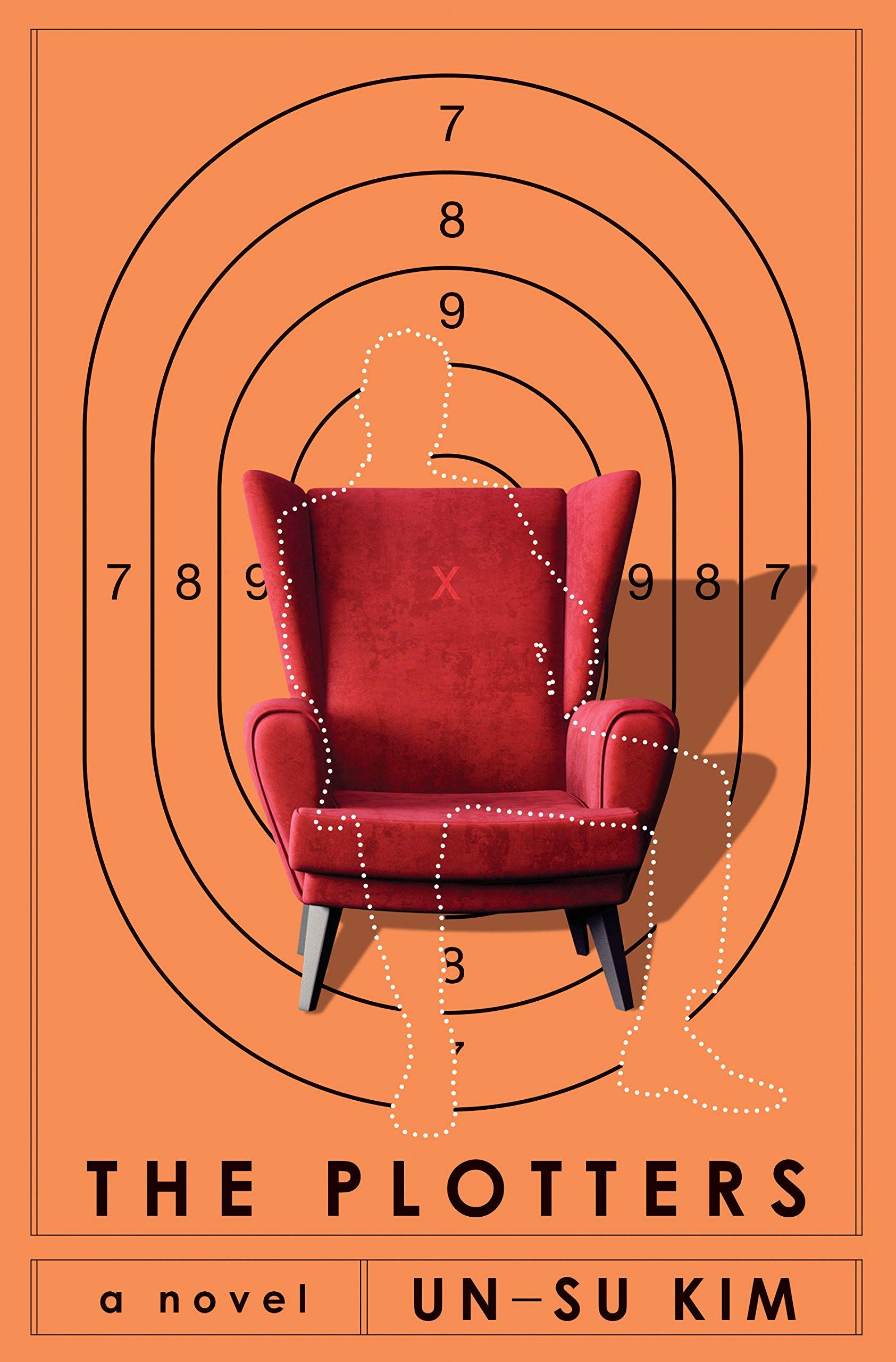
I use a highlighter for any word that I don’t know while reading the Korean version. After a reading session, I then immediately input all new words into Anki, and this is key, I then immediately study all of that new vocabulary instead of Anki’s default 10 or 15 or whatever. Some days when I am being aggressive, I might study 150 or even 300 new vocabulary words in a massive wave. If you don’t immediately learn all of that new vocabulary, you are going to forget all of it really, really fast. So just start the memorization process as fast as possible.
After a few cycles, I re-read the section in the novel where the vocabulary came from, and suddenly I am reading quite rapidly. What’s also great — and I think typical of most writing — is that authors use the same words again and again. So when I memorize words from earlier in the book, these same words have a habit of reappearing later — and suddenly I am able to just keep reading through the book without stopping.
You don’t need to just read novels of course. Listen to music or movies with subtitles, or read a newspaper article. Just be sure to save the content, so that you can revisit it occasionally and further implant that vocabulary and context in your brain.
So, how it is all going
I restarted this process a couple of months ago. So far, I am in much better shape than three years ago, and growing rapidly. This whole setup isn’t perfect, but it is better than I had before. The biggest block I have now is just finding time to read Korean and listen to Korean, since that is time consuming to say the least.
Finally, here is my version 1.0 and version 3.0 decks. Feel free to check out their structures, although ignore perhaps the large number of gun vocabulary in version 3.0 (I am reading a Korean crime noir after all, so words like ‘gun striations’ probably shouldn’t be at the top of your list).
Featured image by Wilson Loo Kok Wee used under Creative Commons.